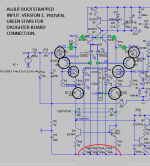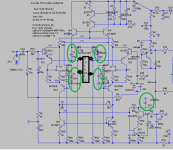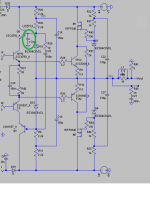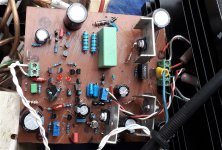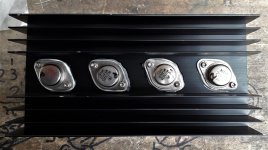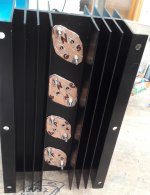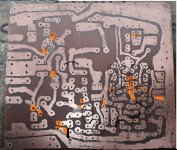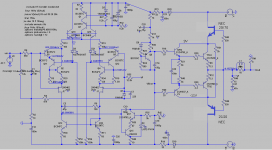BTW, what a lovely reading!
And stimulus for further investigation or re-trying.
The Baxandall Papers: Transitional Miller compensation
I feel comforted by the fact that the Ascended Masters also experienced oscillation during their experimentation.
Cheers,
M.
And stimulus for further investigation or re-trying.
The Baxandall Papers: Transitional Miller compensation
I feel comforted by the fact that the Ascended Masters also experienced oscillation during their experimentation.
Cheers,
M.
I found today this very interesting article by Jan Didden about transient thermal variation induced bias current of output devices.
https://linearaudio.nl/sites/linearaudio.net/files/v9 jd_0.pdf
Dear Jan did not evaluate the effect of supply voltage (total power) faced by the devices. I wish he had evaluated cascodying of the devices under test.
of the devices under test.
Also, the final conclusion worry me: since no effect on THD was observed, then the thermal effect "is unlikely" to be audible...
Again, I believe time-based effects are more important than frequency-based effects on audibility or enjoyment of the amplifier.
It seems, dear JOSI1 one, that nobody believes us when we say that bootstrapped outputs are more enjoyable than plain common collector outputs...
Cheers,
M.
https://linearaudio.nl/sites/linearaudio.net/files/v9 jd_0.pdf
Dear Jan did not evaluate the effect of supply voltage (total power) faced by the devices. I wish he had evaluated cascodying
Also, the final conclusion worry me: since no effect on THD was observed, then the thermal effect "is unlikely" to be audible...
Again, I believe time-based effects are more important than frequency-based effects on audibility or enjoyment of the amplifier.
It seems, dear JOSI1 one, that nobody believes us when we say that bootstrapped outputs are more enjoyable than plain common collector outputs...
Cheers,
M.
Who cares, it’s only your satisfaction that counts.It seems, dear JOSI1 one, that nobody believes us when we say that bootstrapped outputs are more enjoyable than plain common collector outputs...
Cheers,
M.
Take 5 modern amps, they probably all have similar sub audible distortion figures, nevertheless most likely they will have different sonic characters.
Conclusion, there’s probably more between sky and earth than just harmonic distortion.
Follow your ears, measurements are quite helpful but not conclusive.
And don’t see minimal thermal distortion as the ultimate religion.
It may or may not bring something, try it at different spots and let your ears decide at the end.
Hans
I know, dear Hans, but my spirit of service is disillusioned... 
BTW, have you played with FETs?
I would recommend that people buy some while they last.
Sellers are accepting offers.
A PAIR OF Audio Transistor SONY TO-3 2SJ18/2SK60 | eBay
Cheers,
M.
BTW, have you played with FETs?
I would recommend that people buy some while they last.
Sellers are accepting offers.
A PAIR OF Audio Transistor SONY TO-3 2SJ18/2SK60 | eBay
Cheers,
M.
Only in the very very past when Sansui introduced their V-Fets.I know, dear Hans, but my spirit of service is disillusioned...
BTW, have you played with FETs?
I would recommend that people buy some while they last.
Cheers,
M.
Since then I got addicted to Class A amps and never changed from there.
It’s like falling in love with a women for the rest of your life
Hans
Women means more than one.It’s like falling in love with a women for the rest of your life.
Women means more than one.
Look again in your dictionary
Women means more than one.
So it should be 'wom'
Who cares, it’s only your satisfaction that counts.
Follow your ears, measurements are quite helpful but not conclusive.
And don’t see minimal thermal distortion as the ultimate religion.
It may or may not bring something, try it at different spots and let your ears decide at the end.
Hans
You will soon see that I have been following this path.
Do you mean Tube Class A?
Vfets also make good class A amps. My Tokin class amp with LTMD front end is a good example. If it weren't too crowded inside, I will have its output cascoded already.
Cher Forr,
Soyez le bienvenu.
Alllonsenfantsdelapatrie
Dear Forr, be welcome.
Cheers,
M.
Or could it be the BA-1000?
Max, you are a warm-harted man, one of the greatest humanists of our time, but a bad circuit designer. This is audio. Signal propagation is a history dependent process. Amplifiers ought to have a memory like an elephant.
He, he. You are completely right. I am not a circuit designer at all. That is why I try to seduce real designer to cooperate in this improbable endeavor.
But do not focus on memory. Memory is just an alibi (to catch the attention) to explore new strategies for better sound. I am trying to understand how the low level signal gets completely F***d when passing through the multiple stages. Those tinny currents are to be cherished and protected, it seems. It is of paramount importance that we get micro-macro-dynamics right. Take a look at Lavardin amplifiers' reviews (reading review is a PIA, I know) and you will notice that sound descriptions are comparable with ours...
Since (and thanks to the fact that) I have no technical background, I can explore and use trial-and-error-trial-and -success strategy...hunches and intuition.
Now to the important matters, risking to worry Hans further.
Does a warm-heart gets to be known through internet messages???
Is it possible to convey more than letters through these boards???
Can a heart know something???
In Spanish (Castellano) a hunch is translated to "corazonada" (heart=corazón) and so, there are multiple expressions relating heart and emotions (obviously) but also to wisdom, in most languages known to mankind...there must be a reason for this...
We are very fond of our deductive and inductive capacity (though we use more retro-ductive capacity in real life) and reasoning power of our brain, even if it is seldom necessary in everyday life. Modern educational system privileges one hemisphere over the other (left more than right or vice versa) given the chosen career or path. Because balance is one of Nature's principles, one must develop "the other side" to have a balanced growth of the Mind's powers and possibilities. Once we understand this, we know that this is not enough. There is one other leg of the table missing...if one is going to obtain Wisdom (instead of only collecting common knowledge or Data) and that is, ta-ra-ta-ta!... the Heart. Note that I write this at the risk of loosing my last bit of credibility that I may still have left
Anyway, playing with electronics is a fun hobby and a window to higher accomplishments, I hope.
With unconditional Love,
M.
Maxlorenz ,
I have made hundreds of schemes, some sounded good and others not, but I have been unable to isolate in a simulator the causes of a good sound,
I have measured times, voltages ,intensities, but nothing at all .
I think this has to do with the nature of the audio signals, so only intuition can help.
But you have to take the right path, and this is the hard part .
If you look THD ,for example , you are bound to fail .
This papers help me a lot .
BR
I have made hundreds of schemes, some sounded good and others not, but I have been unable to isolate in a simulator the causes of a good sound,
I have measured times, voltages ,intensities, but nothing at all .
I think this has to do with the nature of the audio signals, so only intuition can help.
But you have to take the right path, and this is the hard part .
If you look THD ,for example , you are bound to fail .
This papers help me a lot .
BR
Attachments
Looking the mentioned pdf .
What can go wrong in a solid state desing? jeje .
Varicaps, input and output capacitors, temperature variables ,heavy doping effect ,early effect , VBE , base-width modulation, charge conditions,storage time, forward transit time ,BF , and so on .
But there must be one that is the worst for audio amplifiers .
It has taken me years to find it and it is in this book .
BR
What can go wrong in a solid state desing? jeje .
Varicaps, input and output capacitors, temperature variables ,heavy doping effect ,early effect , VBE , base-width modulation, charge conditions,storage time, forward transit time ,BF , and so on .
But there must be one that is the worst for audio amplifiers .
It has taken me years to find it and it is in this book .
BR
Last edited:
Max,
striving for balance is one of Nature's principles. However, balance precludes signal transmission so in audio (and thinking) it is a nuisance.
I am coming up with some practical suggestions without explanation, please consider or disregard them.
Input stage:
Implement a JFET / bipolar cascode (not vice versa), no differential amplifier, no memory transistor
VAS:
Common base or common emitter configuration, no cascode
Output stage:
You could go for the MOSFET / VFET cascode à la BA-1000
Moreover use resistors only
I am not impressed by the artwork in post #672, to put it politely. (Actually, it is terrible)
striving for balance is one of Nature's principles. However, balance precludes signal transmission so in audio (and thinking) it is a nuisance.
I am coming up with some practical suggestions without explanation, please consider or disregard them.
Input stage:
Implement a JFET / bipolar cascode (not vice versa), no differential amplifier, no memory transistor
VAS:
Common base or common emitter configuration, no cascode
Output stage:
You could go for the MOSFET / VFET cascode à la BA-1000
Moreover use resistors only
I am not impressed by the artwork in post #672, to put it politely. (Actually, it is terrible)
Maxlorenz ,
I have made hundreds of schemes, some sounded good and others not, but I have been unable to isolate in a simulator the causes of a good sound,
I have measured times, voltages ,intensities, but nothing at all .
I think this has to do with the nature of the audio signals, so only intuition can help.
But you have to take the right path, and this is the hard part .
If you look THD ,for example , you are bound to fail .
This papers help me a lot .
BR
Get it all here
Modern Semiconductor Devices for Integrated Circuits
Thank you guys, Ramcres, N101 and FdW for your comments and links.
Dear Ramcres,
I will certainly examine that. I am officially on vacation.
Take a look on what a piece of Paradise the Good Lord sent me to:
YouTube
But today it is raining. or better
or better 
Dear N101,
These are certainly interesting strategies but also that would be a totally different amp. Let me first exploit the last bit of musicality of this one.
Now to the update.
These monsters of amps of mine have, as you may have noticed, a tendency to oscillation in real life. Blame it on bad design or bad PCBs (JOSI1's apparently less prone to oscillation) or the mess of an experimental circuit, the thing is that either they tended (both versions) to show oscillation at the peaks of the positive going sine, which then could transform into full oscillation if volume was pushed up, either they went into full oscillation without warning. As an eternal beginner, I was desperate but I found an article (I think the author is our Bonsai) about the effect of cascodying in oscillation. A cap from base to ground of the driver's cascode (a bootstrap in reality) cured the problem in that particular system. I started with 100nF then dropped it until 10nF good quality film cap. Then I forget it. I believe I could go as low as 1nF but I lack those for the moment.
The full blown oscillation was tracked and cured when using a cap from base to ground of the VAS cascode. Again, I reduced the value until 22nF in one amp and 10nF in the other.
While doing that stressing task of taming oscillation, I was more focused on oscilloscope than on sound. Now my oscilloscope is not working so I can focus on sound.
Thanks to one channel of my red PCB (Ex-DX-HR II amp) oscillating when pulling on/off the lights of the room or the patio (!) with an arch felt and a pop from one speaker, even when the sound system is connected to an exclusive system with its own ground bar...I re-examined what could be wrong. This Electric Universe is amazing.
It was apparent that if forgot to reduce the 100nF cap from base to ground on the driver's bootstrap of that particular channel. Reducing it from 100 to 47nF, avoided the oscillation from the audio room lights but not from the patio lights Then reducing it further to 10nF makes it sensitive only to one of the patio lights, one of low wattage. So the effect is "tunable". I think the radiated EM pulse is captured by the speaker cables maybe and coupled to a tuned oscillator tank. I have to re-do the zobel and put it again before the R//L fillter, as now it is at the speaker's binding posts. Maybe that will cure the instability. I can also install snubber caps on the light's interruptors.
Then reducing it further to 10nF makes it sensitive only to one of the patio lights, one of low wattage. So the effect is "tunable". I think the radiated EM pulse is captured by the speaker cables maybe and coupled to a tuned oscillator tank. I have to re-do the zobel and put it again before the R//L fillter, as now it is at the speaker's binding posts. Maybe that will cure the instability. I can also install snubber caps on the light's interruptors. 
But, what we have to do with all this nonsense? you may be asking...
Here is the aspect of that adventure that has to do with our previous comments with Hans and Ramcres: the reduction to 10nF on the driver's bootstrap base-to-ground DID have a noticeable sound effect. It is subtle but significant and what makes me write this is that it is the same type of effect that I encountered when exploring the use of bypass caps //LEDs of the ALLBJT input (which now has one N-JFET) suggested by non-objectionable simulations, and where I noticed the same subtle effect which was obvious when I came back to no caps. I will attach a diagram for clarity. Even if I was checking the scope screen and not focusing on sound when experimenting with the VAS cascode (not touched since) I believe no sound effect was evident. I would have to re-experiment it if you force me.
So, the best is not to have to install caps at all but if you are forced, use the smallest that fixes it because: the addition of caps make the sound softer, rounder and more polite, but micro and macro dynamics suffer, and images get fuzzier and background is not so black. Going back to smallest cap in the case of the drivers' bootstrap or no cap in the case of the ALLBJT input restores dynamics and black background and even channel separation improves, with more solid images. Now I am on the process of evaluating if the present configuration is the preferred one. I also attach the present (good) hybrid or compound Sziklai input.
But why is that? My explanation as an amateur is that, in a bootstrap, as simulations show, signal is applied to two legs of the transistor, or better, signal is also applied to the base (gate) and that signal is useful and good for sound (dynamics, low level detail...etc) so when I use a cap to tame the oscillation, current is wasted (or waves are modulated; or else) on that cap. On the VAS' cascode BJT (the VAS is "bootstrapped" by a cap on the CCS also, hence the name), the base has no signal so the cap has no effect on sound quality. Does this make sense?
Maybe that is why I stubbornly insist on getting the QUAD bootstrap right...
as the effect on dynamics is cumulative, IMHO.
I am buying 1nF quality caps.
I hope you don't find this one excessively long, he, he.
M.
Dear Ramcres,
I will certainly examine that. I am officially on vacation.
Take a look on what a piece of Paradise the Good Lord sent me to:
YouTube
But today it is raining.
Dear N101,
These are certainly interesting strategies but also that would be a totally different amp. Let me first exploit the last bit of musicality of this one.
Now to the update.
These monsters of amps of mine have, as you may have noticed, a tendency to oscillation in real life. Blame it on bad design or bad PCBs (JOSI1's apparently less prone to oscillation) or the mess of an experimental circuit, the thing is that either they tended (both versions) to show oscillation at the peaks of the positive going sine, which then could transform into full oscillation if volume was pushed up, either they went into full oscillation without warning. As an eternal beginner, I was desperate but I found an article (I think the author is our Bonsai) about the effect of cascodying in oscillation. A cap from base to ground of the driver's cascode (a bootstrap in reality) cured the problem in that particular system. I started with 100nF then dropped it until 10nF good quality film cap. Then I forget it. I believe I could go as low as 1nF but I lack those for the moment.
The full blown oscillation was tracked and cured when using a cap from base to ground of the VAS cascode. Again, I reduced the value until 22nF in one amp and 10nF in the other.
While doing that stressing task of taming oscillation, I was more focused on oscilloscope than on sound. Now my oscilloscope is not working so I can focus on sound.
Thanks to one channel of my red PCB (Ex-DX-HR II amp) oscillating when pulling on/off the lights of the room or the patio (!) with an arch felt and a pop from one speaker, even when the sound system is connected to an exclusive system with its own ground bar...I re-examined what could be wrong. This Electric Universe is amazing.
It was apparent that if forgot to reduce the 100nF cap from base to ground on the driver's bootstrap of that particular channel. Reducing it from 100 to 47nF, avoided the oscillation from the audio room lights but not from the patio lights
But, what we have to do with all this nonsense? you may be asking...
Here is the aspect of that adventure that has to do with our previous comments with Hans and Ramcres: the reduction to 10nF on the driver's bootstrap base-to-ground DID have a noticeable sound effect. It is subtle but significant and what makes me write this is that it is the same type of effect that I encountered when exploring the use of bypass caps //LEDs of the ALLBJT input (which now has one N-JFET) suggested by non-objectionable simulations, and where I noticed the same subtle effect which was obvious when I came back to no caps. I will attach a diagram for clarity. Even if I was checking the scope screen and not focusing on sound when experimenting with the VAS cascode (not touched since) I believe no sound effect was evident. I would have to re-experiment it if you force me.
So, the best is not to have to install caps at all but if you are forced, use the smallest that fixes it because: the addition of caps make the sound softer, rounder and more polite, but micro and macro dynamics suffer, and images get fuzzier and background is not so black. Going back to smallest cap in the case of the drivers' bootstrap or no cap in the case of the ALLBJT input restores dynamics and black background and even channel separation improves, with more solid images. Now I am on the process of evaluating if the present configuration is the preferred one. I also attach the present (good) hybrid or compound Sziklai input.
But why is that? My explanation as an amateur is that, in a bootstrap, as simulations show, signal is applied to two legs of the transistor, or better, signal is also applied to the base (gate) and that signal is useful and good for sound (dynamics, low level detail...etc) so when I use a cap to tame the oscillation, current is wasted (or waves are modulated; or else) on that cap. On the VAS' cascode BJT (the VAS is "bootstrapped" by a cap on the CCS also, hence the name), the base has no signal so the cap has no effect on sound quality. Does this make sense?
Maybe that is why I stubbornly insist on getting the QUAD bootstrap right...
as the effect on dynamics is cumulative, IMHO.
I am buying 1nF quality caps.
I hope you don't find this one excessively long, he, he.
M.
Attachments
Last edited:
And the New!
Like we say in boxing...
Finally, my dream of a VFET AMNESIS.
I am using my NEC 2SC70/2SJ20 VFETs. I reserve the Sony for later.
First step: emitter follower output. Everything works OK.
Second step: wired it as VFET bootstrapped Darlington output. Everything works as intended. Very simple mod. The gates of the VFET are connected to output with a 330R only.
Now, I am finishing the second channel.
I am listening to monophonic music with both test speakers (16 Ohm) connected. I won't say how it sound because you know I am totally partial.
I won't say how it sound because you know I am totally partial. 
Third step will be connected as "QUAD", meaning bootstrapped drivers also. I hope it does not oscillate.
Edit: you may see that I am using a big 15uF quality film cap as bootstrap for the VAS and also in use is the N2222 BJT as VAS. Pin adapters are fitted for several key resistors and for the VAS transistor, if the wish for experimenting arises...
Cheers,
M.
Like we say in boxing...
Finally, my dream of a VFET AMNESIS.
I am using my NEC 2SC70/2SJ20 VFETs. I reserve the Sony for later.
First step: emitter follower output. Everything works OK.
Second step: wired it as VFET bootstrapped Darlington output. Everything works as intended. Very simple mod. The gates of the VFET are connected to output with a 330R only.
Now, I am finishing the second channel.
I am listening to monophonic music with both test speakers (16 Ohm) connected.
Third step will be connected as "QUAD", meaning bootstrapped drivers also. I hope it does not oscillate.
Edit: you may see that I am using a big 15uF quality film cap as bootstrap for the VAS and also in use is the N2222 BJT as VAS. Pin adapters are fitted for several key resistors and for the VAS transistor, if the wish for experimenting arises...
Cheers,
M.
Attachments
Last edited:
- Home
- Amplifiers
- Solid State
- The AMNESIS amp: a good amplifier, like a gentleman, has no memory.
